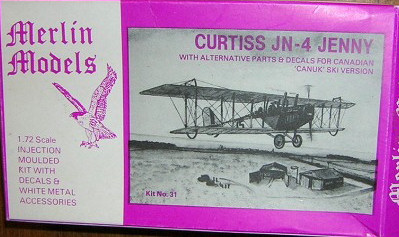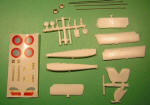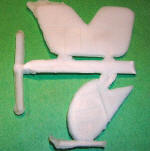
| KIT: | Merlin 1/72 JN-4 'Jenny' |
| KIT #: | 31 |
| PRICE: | $20 back when that much bought two tanks of gas! |
| DECALS: | One option |
| REVIEWER: | Joel Hamm |
| NOTES: | Short run |

| HISTORY |
Awhile back I did a “Kits From Hell” preview series on the first generation of short run 1/72 injection molded models. When they appeared about 20 years ago they offered the experienced modeler a chance to build subjects the likes of which were available only in vacu-form, if at all. Many of those planes have since been kitted in less masochistic form by the Czech, Chinese, Russian, or even Japanese companies; leaving the originals fit only to be collected, tossed into a vat of methyl-ethyl ketone and converted to DIY putty, or sent to as Christmas gifts to “G’itmo” to cheer some shut-in Al Qaida operative.
While rooting around the stash, I uncovered another heap of these rough gems. Some are not-bad-at-all; some are as good as any of the current short-runners, some are still the only show in town for those subjects, notably Merlin’s Thomas Morse Scout and Curtiss Racer. Merlin’s JN-4 Jenny borders on the buildable. It suffers from no disqualifying defects, other than the contemporary release of a much better version from Pegasus (stand-by this frequency for a preview), and a current cornucopia from the newcomer, Olymp, of beautifully rendered multiple versions, including the seaplane.
The Jenny is an aviation legend with Lord-knows-how-many books and references devoted to it. What more can possibly be said in a paragraph. Oh, alright. It was born before WWI, saw brief action chasing Poncho villa, trained just about all US pilots in The War to Start All Wars, re-upped in the Twenties in assorted training roles, and served as the favorite mount of barnstormers.
| THE KIT |
 The photos show (I hope) what was bought for the then exorbitant score of George
Washingtons. Major pieces are injected semi-soft white plastic, properly thin,
with well defined raised surface detail. Flash is minimal, considering the early
technology; but sprue gates are large and extend into the parts – meaning
careful cutting and filing.
The photos show (I hope) what was bought for the then exorbitant score of George
Washingtons. Major pieces are injected semi-soft white plastic, properly thin,
with well defined raised surface detail. Flash is minimal, considering the early
technology; but sprue gates are large and extend into the parts – meaning
careful cutting and filing.
 Fuselage
halves suffer a curved deformity, which is probably curable with a hot-water
dunking and bit of brute force. The wing panels inherit a problem that plagued
many Merlin airfoils. I call it a “taffy-pull syndrome”, which leaves the
proximal and distal sections thinner than the center, as if the part had been
stretched span-wise. The under-cambered wing and raised rib detail would make
correction a bit of a tickle; but as the head-on photo shows, it’s not so
pronounced as to be unlivable-with.
Fuselage
halves suffer a curved deformity, which is probably curable with a hot-water
dunking and bit of brute force. The wing panels inherit a problem that plagued
many Merlin airfoils. I call it a “taffy-pull syndrome”, which leaves the
proximal and distal sections thinner than the center, as if the part had been
stretched span-wise. The under-cambered wing and raised rib detail would make
correction a bit of a tickle; but as the head-on photo shows, it’s not so
pronounced as to be unlivable-with.
 Struts are provided as lengths of Plastruct extrusions (a nifty product no
longer available). Seats are porous white metal (resin’s precursor). Landing
gear legs and other small parts need to be scratch built; and the prop, although
provided, must come from the spares bin. Jennies were often flown with their
OX-5’s 8 cylinders enjoying the breeze, but this one is molded with closed cowls
and no engine is available.
Struts are provided as lengths of Plastruct extrusions (a nifty product no
longer available). Seats are porous white metal (resin’s precursor). Landing
gear legs and other small parts need to be scratch built; and the prop, although
provided, must come from the spares bin. Jennies were often flown with their
OX-5’s 8 cylinders enjoying the breeze, but this one is molded with closed cowls
and no engine is available.
Textual instructions (“…glue on this piece, then add that…etc…”) are useless for locating parts, but the well drawn 1/72 3-view plans assist rigging – if nothing else. Decals are included for only one Canadian plane, though I can’t vouch for the accuracy of the gray color in the roundels and rudder stripes, which most certainly must have been blue. Markings appear to be thin, in-register, with no carrier film; and have survived 20 years of basement storage without yellowing (more than can be said about this reviewer).
| CONCLUSIONS |
The kit appears to be buildable without too much wailing or gnashing of teeth, but why bother when Olymp offers so many choices all in excellent quality.
April 2006
If you would like your product reviewed fairly and quickly by a site that has over 300,000 visitors a month, please contact me or see other details in the Note to Contributors.